Tire Size 33×12.50r20 vs 35×12.50r20
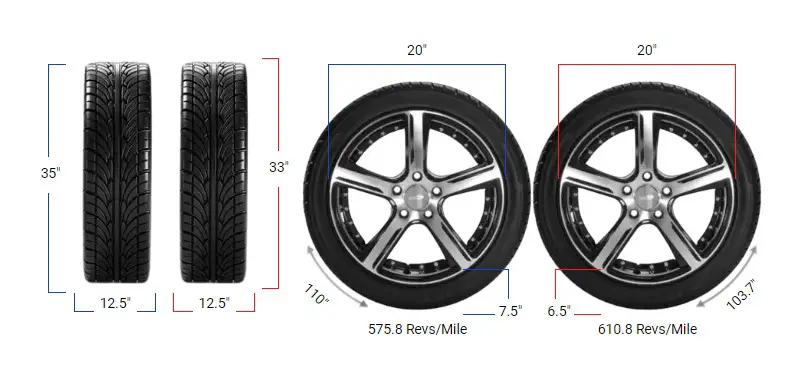
The primary distinction between 33×12.50r20 and 35×12.50r20 tires lies in their overall diameter. The 35-inch tires are 2 inches larger in diameter, resulting in a 5.7% increase.
This change significantly impacts vehicle performance, clearance, and handling characteristics, both on and off-road.
- Tire diameter increases by 2 inches, exceeding the recommended 3% change
- Ground clearance improves, enhancing off-road capability
- Fuel efficiency may decrease due to larger, heavier tires
- Speedometer accuracy is affected, showing slower speeds than actual
- Potential rubbing issues may require vehicle modifications
33×12.50r20 vs 35×12.50r20
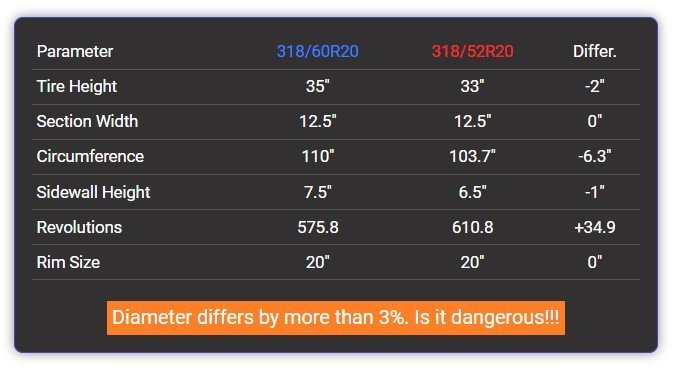
Fitment Guide
It’s crucial to consider the fitment guide. The diameter difference between these tire sizes is 5.7%, which exceeds the acceptable range of plus or minus 3%. This means the interchange is not recommended without making necessary adaptations to your vehicle.
To accommodate the larger tires, you may need to make several modifications:
- Lift kit: Installing a lift kit can provide the extra space needed for the larger tires to fit without rubbing against the fenders or suspension components.
- Fender trimming: In some cases, you might need to trim or modify the fenders to prevent tire rubbing during full suspension articulation or when turning.
- Wheel spacers: These can help move the tires outward, providing more clearance between the tire and suspension components.
- Gear ratio change: Adjusting the gear ratio can help compensate for the larger tire size, maintaining proper engine RPM and vehicle performance.
- Brake upgrades: Larger tires mean more rotating mass, which can affect braking performance. Upgrading your brake system may be necessary to ensure safe stopping power.
Remember, these modifications can be complex and may affect your vehicle’s warranty. It’s always best to consult with a professional mechanic or off-road specialist before making such significant changes to your vehicle.
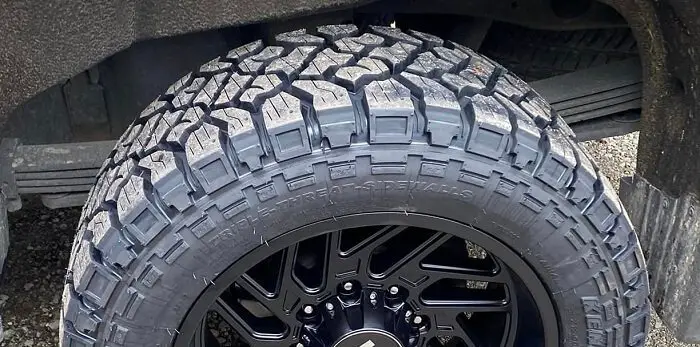
On-Road Impact
Switching to larger tires can significantly affect your vehicle’s on-road performance. Let’s examine how the change from 33-inch to 35-inch tires impacts various aspects of on-road driving.
- Gas Mileage: The increased size and weight of 35-inch tires can lead to reduced fuel efficiency. The larger tires create more rolling resistance, which means your engine has to work harder to maintain the same speed. This extra effort translates to increased fuel consumption. You might notice a decrease in gas mileage of about 1-2 mpg, depending on your driving habits and vehicle type.
- Speedometer Accuracy: The larger circumference of 35-inch tires affects your speedometer reading. With the new tires, your actual speed will be about 6.1% faster than what your speedometer shows. For example, when your speedometer reads 60 mph, you’ll actually be traveling at about 63.7 mph. This discrepancy can be crucial for maintaining legal speeds and avoiding tickets.
- Ride Comfort: The taller sidewalls of 35-inch tires can provide a smoother ride over small bumps and road imperfections. However, the increased unspring weight might make the suspension feel less responsive, potentially reducing overall ride quality on smooth roads.
- Acceleration and Braking: The heavier 35-inch tires increase rotational mass, which can slightly reduce acceleration performance. You might notice your vehicle feels a bit sluggish when starting from a stop or during quick acceleration. Braking distances may also increase due to the additional weight, so it’s important to adjust your driving habits accordingly.
- Handling: Larger tires can affect your vehicle’s handling characteristics. The increased height may lead to a higher center of gravity, potentially increasing body roll during cornering. However, the wider tread pattern can provide better grip in dry conditions, which could improve overall traction.
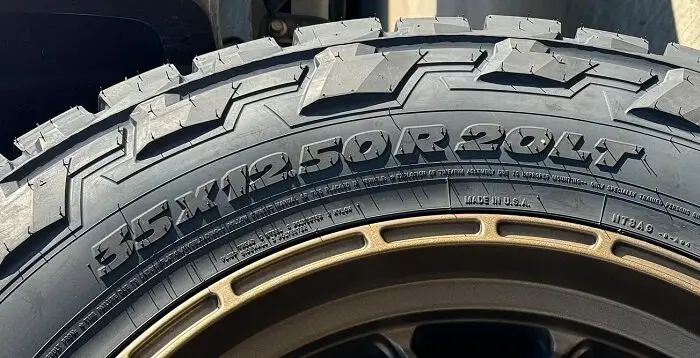
Off-Road Impact
The switch to 35-inch tires can dramatically enhance your vehicle’s off-road capabilities. Here’s how the larger tires affect your off-road adventures.
- Ground Clearance: One of the most significant benefits of upgrading to 35-inch tires is the increase in ground clearance. The 2-inch larger diameter provides an extra inch of clearance under your vehicle’s axles and differential. This additional space can make a big difference when navigating over rocks, logs, or other obstacles on the trail.
- Traction: The larger contact patch of 35-inch tires offers improved traction in various off-road conditions. Whether you’re dealing with mud, sand, or loose gravel, the increased surface area helps distribute the vehicle’s weight more effectively, reducing the chances of getting stuck.
- Water Fording: The taller tires allow for deeper water crossings without risking engine damage. The extra height can be crucial when navigating streams or flooded areas during your off-road excursions.
- Obstacle Clearance: Larger tires make it easier to roll over obstacles like rocks and logs. The increased diameter allows the tire to maintain more consistent contact with the ground, reducing the likelihood of high-centering your vehicle.
- Durability: 35-inch tires typically have stronger sidewalls, which are less prone to punctures from rocks and other sharp objects encountered off-road. This increased durability can provide peace of mind during challenging trail runs.
- Aesthetics: While not directly related to performance, many off-road enthusiasts appreciate the more aggressive and capable look that 35-inch tires provide. The larger tires can give your vehicle a more imposing presence both on and off the trail.
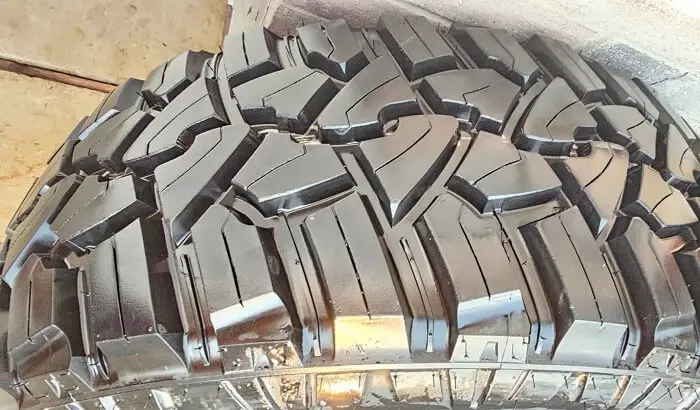
What is the Difference Between 35×12.5r20 and 33×12.5r20?
The main difference between 35×12.5r20 and 33×12.5r20 tires is their overall diameter. The 35×12.5r20 tire has a diameter of 35.02 inches, while the 33×12.5r20 tire has a diameter of 33.02 inches.
This 2-inch difference in diameter results in a 5.7% increase in overall size, which significantly impacts various aspects of vehicle performance, including ground clearance, speedometer accuracy, and fuel efficiency.
The larger 35-inch tire offers improved off-road capabilities but may require vehicle modifications for proper fitment and optimal on-road behavior.
Can I Use 35×12.5r20 Instead of 33×12.5r20?
No, it is not recommended to use 35×12.5r20 tires instead of 33×12.5r20 without making necessary modifications to your vehicle. The diameter difference between these tire sizes is 5.7%, which exceeds the generally acceptable range of plus or minus 3%.
This significant size increase can lead to fitment issues, altered vehicle dynamics, and potential safety concerns. To safely use 35×12.5r20 tires, you may need to install a lift kit, modify fenders, adjust gear ratios, and possibly upgrade your braking system. Always consult with a professional before making such a significant change to your vehicle’s tire size.
How Much Taller Is A 35×12.5r20 Tire Than A 33×12.5r20?
A 35×12.5r20 tire is exactly 2 inches (50.88 mm) taller than a 33×12.5r20 tire. The 35×12.5r20 tire has a diameter of 35.02 inches (889.6 mm), while the 33×12.5r20 tire has a diameter of 33.02 inches (838.72 mm).
This difference in height translates to a 5.7% increase in overall diameter, which can significantly affect your vehicle’s ground clearance, speedometer accuracy, and overall performance.
How Much Wider is a 35×12.5r20 Tire Than a 33×12.5r20?
There is no difference in width between a 35×12.5r20 tire and a 33×12.5r20 tire. Both tires have the same width of 12.52 inches (318 mm).
The “12.5” in both tire sizes refers to the tire’s width in inches, which remains constant. The main difference between these two tire sizes is in their overall diameter and sidewall height, not their width.
Our Observation
Switching from 33×12.50r20 to 35×12.50r20 tires offers notable benefits for off-road enthusiasts, including increased ground clearance, better obstacle navigation, and improved traction in challenging terrain.
However, this upgrade comes with trade-offs, such as reduced fuel efficiency, altered speedometer readings, and potential strain on vehicle components.
The 5.7% increase in diameter, while exceeding the recommended 3% threshold, can significantly enhance off-road capabilities without drastically compromising on-road performance for most users.
For daily driving, the differences in handling and comfort are often negligible once drivers adjust to the new tire size.
Off-road, the benefits are more pronounced, making this upgrade worthwhile for those who frequently tackle rough terrain. Ultimately, the decision to switch should balance off-road aspirations with on-road practicality and necessary vehicle modifications.

Meet Caitlin McCormack, a Tire Size Expert and Blogger Passionate About Everything Related to Tires. With Years of Experience in the Tire Industry, Caitlin Has Become an Expert in Tire Sizes and Their Impact on Vehicle Performance.
